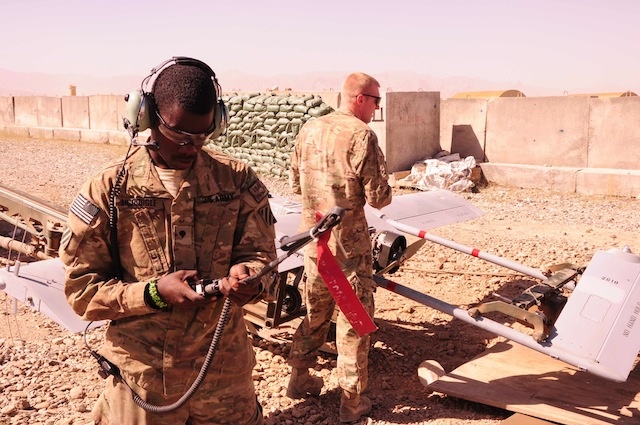 Geography rules in eastern Afghanistan. Rugged mountains and rocky plains make it a difficult trek for people, but well-suited for donkeys and UAS. And these days the region has its share of both.
Geography rules in eastern Afghanistan. Rugged mountains and rocky plains make it a difficult trek for people, but well-suited for donkeys and UAS. And these days the region has its share of both.
On NATO’s Forward Operating Base Shank in Logar Province, US Army Staff Sergeant Kane Featherston and Specialist Torrin McDougle, both of 4-3 Brigade’s Special Troops Battalion, prepare a battleship grey aircraft for launch.
The Shadow 200, made by the AAI Corporation, is the width of a garage door. Depending on its configuration, it can weigh as much as 425 pounds.
While at first glance this unmanned aircraft system or UAS doesn’t look much different than a hobbyist’s radio controlled plane, it’s sophisticated guidance, flight, and surveillance technology put it in the price range of approximately $1 million.
But officers here believe the small package is worth the price, considering the intelligence it provides Task Force Vanguard.
“It’s the smallest of the big UAS and biggest of the small UAS,” according to Lieutenant Mark McConnell, the platoon leader in charge of the Shadow’s operations here.
While it can be mounted with weapons, McConnell says that’s not it’s purpose for Task Force Vanguard. The drone is used to gather intelligence about Taliban movements as well as provide and “eye in the sky” overwatch for US and Afghan National Army troops while they’re out on patrol.
Within minutes after Featherston and McDougle load the Shadow onto a hydraulic, nitrogen-powered catapult, the Shadow will accelerate from zero to 70 before it hits the end of its ramp, airborne and scanning the region around Logar and Wardak Provinces.
Pilots operate the UAS from a Ground Control System based in the back of a vehicle, moving the aircraft with a computer mouse. Flying the UAS can be a challenge in Afghanistan, winds, updrafts, mountains, and other obstacles mean the pilots need to be on highly alert during the six to nine hours the Shadow can remain airborne.
Because American and Afghan troops are patrolling so frequently, a squadron of million-dollar Shadows are logging 36-40 hours of flight time every day here, over the inhospitable and often dangerous terrain below.
Source: Motherboard
